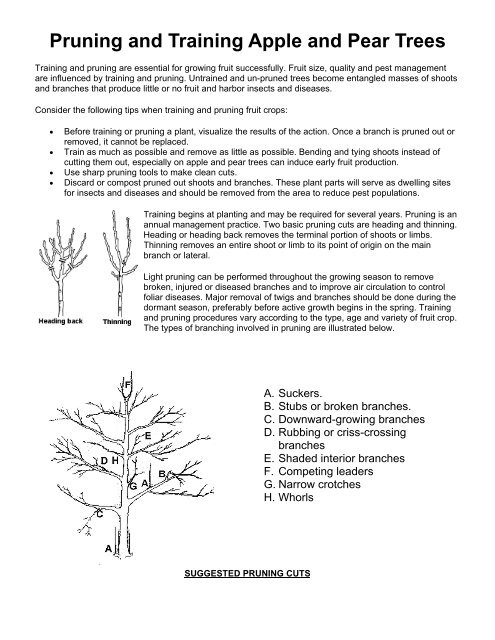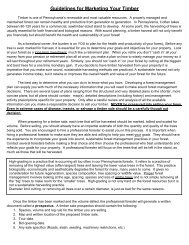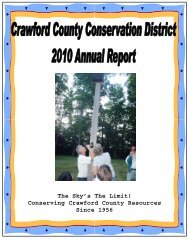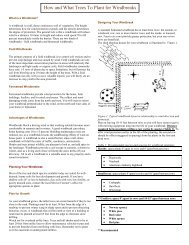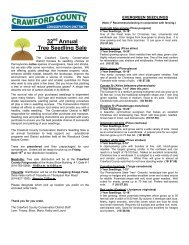Pruning and Training Apple and Pear Trees
Pruning and Training Apple and Pear Trees
Pruning and Training Apple and Pear Trees
Create successful ePaper yourself
Turn your PDF publications into a flip-book with our unique Google optimized e-Paper software.
<strong>Pruning</strong> <strong>and</strong> <strong>Training</strong> <strong>Apple</strong> <strong>and</strong> <strong>Pear</strong> <strong>Trees</strong><br />
<strong>Training</strong> <strong>and</strong> pruning are essential for growing fruit successfully. Fruit size, quality <strong>and</strong> pest management<br />
are influenced by training <strong>and</strong> pruning. Untrained <strong>and</strong> un-pruned trees become entangled masses of shoots<br />
<strong>and</strong> branches that produce little or no fruit <strong>and</strong> harbor insects <strong>and</strong> diseases.<br />
Consider the following tips when training <strong>and</strong> pruning fruit crops:<br />
• Before training or pruning a plant, visualize the results of the action. Once a branch is pruned out or<br />
removed, it cannot be replaced.<br />
• Train as much as possible <strong>and</strong> remove as little as possible. Bending <strong>and</strong> tying shoots instead of<br />
cutting them out, especially on apple <strong>and</strong> pear trees can induce early fruit production.<br />
• Use sharp pruning tools to make clean cuts.<br />
• Discard or compost pruned out shoots <strong>and</strong> branches. These plant parts will serve as dwelling sites<br />
for insects <strong>and</strong> diseases <strong>and</strong> should be removed from the area to reduce pest populations.<br />
<strong>Training</strong> begins at planting <strong>and</strong> may be required for several years. <strong>Pruning</strong> is an<br />
annual management practice. Two basic pruning cuts are heading <strong>and</strong> thinning.<br />
Heading or heading back removes the terminal portion of shoots or limbs.<br />
Thinning removes an entire shoot or limb to its point of origin on the main<br />
branch or lateral.<br />
Light pruning can be performed throughout the growing season to remove<br />
broken, injured or diseased branches <strong>and</strong> to improve air circulation to control<br />
foliar diseases. Major removal of twigs <strong>and</strong> branches should be done during the<br />
dormant season, preferably before active growth begins in the spring. <strong>Training</strong><br />
<strong>and</strong> pruning procedures vary according to the type, age <strong>and</strong> variety of fruit crop.<br />
The types of branching involved in pruning are illustrated below.<br />
A. Suckers.<br />
B. Stubs or broken branches.<br />
C. Downward-growing branches<br />
D. Rubbing or criss-crossing<br />
branches<br />
E. Shaded interior branches<br />
F. Competing leaders<br />
G. Narrow crotches<br />
H. Whorls<br />
SUGGESTED PRUNING CUTS
INITIAL TRAINING AND PRUNING<br />
The day apple trees are planted is the day to begin to train <strong>and</strong> prune for future production. Too often<br />
backyard growers plant apple trees <strong>and</strong> leave them untended for several years. This neglect results in poor<br />
growth <strong>and</strong> delayed fruiting.<br />
<strong>Apple</strong> trees are trained to a modified leader system. The tree should be trained with one central leader or<br />
main trunk in the center, with several wide-angled limbs spaced around the leader. The tree should mature<br />
to a pyramidal shape.<br />
The picture below shows correct <strong>and</strong> incorrect pruning of an apple tree.<br />
Use "spur-type" strains or grow apples on dwarfing<br />
rootstock to make training <strong>and</strong> pruning easier. Spur-type<br />
<strong>and</strong> dwarf trees produce fruit at an earlier age than fullsized<br />
trees. These trees are also easier to manage <strong>and</strong><br />
harvest than full-sized trees are.<br />
If one-year-old un-branched "whips" are planted, head to<br />
the desired height — about 28 to 32 inches for st<strong>and</strong>ard<br />
<strong>and</strong> 30 to 35 inches for spur-type <strong>and</strong> semi-dwarf trees.<br />
When the buds grow out to 4 to 5 inches, select a central<br />
leader <strong>and</strong> scaffold branches. Scaffolds (side branches)<br />
should be spaced at least 6 inches apart vertically <strong>and</strong> at<br />
equal intervals around the trunk. Between three <strong>and</strong> six<br />
branches may be selected as scaffolds during the first<br />
summer or may be left to grow throughout the season<br />
<strong>and</strong> selectively pruned out during the dormant season.<br />
If young trees are branched when they come from the<br />
nursery or garden center, remove any broken branches<br />
<strong>and</strong> those that form angles less than 45° with the main trunk. Eliminate competing leaders by removing the<br />
less desirable branch. Head-back the central leader by one-third in the second year. Make the cut close to a<br />
bud that is growing in a suitable direction or to a lateral branch. Keep pruning to a minimum during the early<br />
years to encourage the trees to produce fruiting wood.<br />
<strong>Pear</strong> trees naturally develop narrow angled, upright branches. To train properly angled scaffold branches,<br />
either weight the branches, tie branches to pegs in the ground or brace the branches apart with spacer<br />
sticks.<br />
PRUNING BEARING TREES<br />
Prune bearing trees to maintain a balance between vegetative growth <strong>and</strong> fruit production. The first three<br />
years should be spent on training only, but by the fourth <strong>and</strong> fifth years, the trees can be allowed to produce<br />
a light crop.<br />
<strong>Pruning</strong> bearing trees is critical to maintain healthy fruiting wood. Remove weak, "shaded-out" wood,<br />
diseased or dead wood, water sprouts <strong>and</strong> root suckers. Control tree height by cutting back the top portion<br />
of the tree to weak lateral branches.<br />
For flower buds to develop well, all branches of the tree should be exposed to adequate sunlight. This can<br />
be a challenge in the lower portion of the tree. On the lowest whorl of secondary scaffolds, merely tip the<br />
terminal shoots of these branches rather than cutting them back to laterals. If the fruit quality <strong>and</strong> yield
diminish in older trees, some heavy pruning may be done carefully to restore tree shape <strong>and</strong> allow more<br />
sunlight to penetrate into the tree.<br />
SUMMER PRUNING<br />
Summer pruning is advised, especially for removing waterspouts, root suckers <strong>and</strong> fire-blight-infected wood.<br />
Summer pruning can also be used during the first three years of tree training to produce the desired tree<br />
shape. Undesired growth should be removed in early summer or after harvest between late August <strong>and</strong><br />
early September. Also, note that pruning should be focused on thinning out rather than heading-back<br />
Heading-back cuts may stimulate new growth near the cut. If the trees are heavily pruned, reduce the<br />
amount of fertilizer applied in relation to the severity of pruning. Heavily pruned trees may not need fertilizer<br />
for a year or two.<br />
THINNING<br />
<strong>Apple</strong> <strong>and</strong> pear trees grown under favorable conditions will set more fruit than they are capable of carrying<br />
to maturity. It is essential to remove excess fruit from the trees to assure satisfactory development of fruit<br />
remaining on the tree. Failure to remove the excess fruit will decrease flower formation for the following year<br />
<strong>and</strong> cause the tree to produce a crop only every other year.<br />
Fruit should be removed by h<strong>and</strong> to one per cluster. Space fruiting clusters about every 6 inches along the<br />
limb. To remove the fruit without damaging the spur or other pears on the spur, hold the stem between the<br />
thumb <strong>and</strong> forefinger <strong>and</strong> push the fruit from the stem with the other fingers. This method will remove the<br />
pear leaving the stem attached to the spur.<br />
The earlier that h<strong>and</strong> thinning is completed, the more effective it will be in achieving the desired results.<br />
Midsummer thinning will help to improve fruit size, but it will not aid in the formation of next year’s flower<br />
buds. Most of the flower buds for next year are initiated during a four to six week period following full bloom,<br />
so thin before this time.<br />
PRUNING NEGLECTED APPLE TREES<br />
Many people will purchase a house where an apple tree was planted on the property several years ago.<br />
Often, the previous owners did not take the time to properly prune the tree. The tree has become bushy <strong>and</strong><br />
weak <strong>and</strong> will produce very poor quality apples. Such a tree requires extensive corrective pruning.<br />
The main objective in pruning such a tree is to try <strong>and</strong> open up the interior to allow good light penetration.<br />
The first step is to remove all the upright, vigorous growing shoots at their base that are shading the interior.<br />
As with the young apple trees, it is necessary to select 3 to 5 lower scaffold branches with good crotch<br />
angles <strong>and</strong> spaced around the tree. Limbs with poor angles, <strong>and</strong> excess scaffold limbs, should be removed<br />
at their base. In some cases it is advisable to spread the corrective pruning over two to three seasons.<br />
When severe pruning is done in the winter, the trees should not be fertilized that spring.<br />
Excerpted from the South Carolina Master Gardener <strong>Training</strong> Manual, EC 678.


